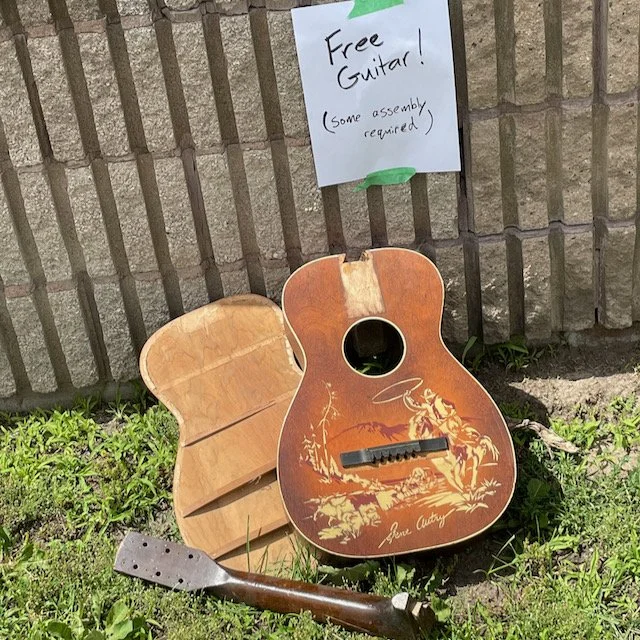THE FINITE LIFE
The average old guitar has been through a life of pain and abuse. So much so, in fact that most of them are dead from it; that’s why the ones that are left are valuable. Scarcity demands a higher price- but only if the instrument in question was good enough in the first place. There are probably more plywood Kays left in this world, mouldering half-forgotten in basements across the continent, than there are mid-century Martins. But the point is that most guitars die because at a certain point they’re just not worth the cost of maintaining. The ones that survive are the ones who, like a mortgage in an economic crisis, maintain a value (monetary or sentimental or utilitarian) above water.
It should be said, too, that the skill applied to repairing these guitars has always been related to the value of of the instrument itself. It is tempting to think that the art of repair has undergone a great blossoming in the past couple of decades; after all, most every luthier has come across a bridge held fast with drywall screws, or a crack closed with fibreglass tape and epoxy, or a neck reset by slipping the back against the neck block. But the art of sensitively restoring other musical instruments is not new. Every old violin has been rebuilt at least once. Most have had cracks closed invisibly, bass bars (the top brace) replaced, new necks installed (while splicing in the original scroll!), among other things. But that is because these instruments were valued enough at every point to be worth spending money to repair. They are the survivors of a continuous winnowing process. It’s important to remember that others weren’t; we simply don’t think about them because they have already disappeared. At a certain point, these super-survivors can even become too valuable to die.
The steel-string guitar is of course much newer. The winnowing process is still very actively underway; I have seen with my own eyes prewar Gibson flattops being put back in cases, to brought back home for retirement as a wall decoration, because the cost to repair it properly was just a little too much. I myself own a mandolin that predates womens’ suffrage, moving pictures, and in fact the whole twentieth century. It does not get played. It probably never really will again. Perhaps this tiny piece of history should be given back to the earth from whence it came. And perhaps this is not only OK, it might even be right. Allow me to explain.
Plucked instruments are marvels of physics. It really is amazing that a single stretch and release of a little length of wire should make enough noise to hear. But indeed we do, thanks to the little boxes of wood they are fastened to, and to thousands of years of human ingenuity refining those boxes to work better at making that noise louder. Put a bunch of those stretches and releases together, and you get music.
There’s not a lot of energy in a string. A few grams (at most) of metal or plastic, moving a few millimetres side to side (at most). If we want to hear it, the resonating box has to be quite light and flexible as well. Unfortunately, that means that over time it will deform further and further from its original shape.
But we can deal with that. Lower the saddle, tweak the truss rod- it’ll do the job for a while. Partial refret? Worth it for all but the lowest grade of instrument. Neck reset? This is where it gets real- good instruments get the job done properly, poor ones… probably not. Maybe a bridge shave to eak out a few more years of service. Unless it’s a bolted-on neck, in which case the calculus is different since the job is cheaper. That explains the relative abundance of functional older Norman and Seagull guitars, at least here in Canada.
Sudden trauma is assessed on a case-by-case basis. Dropping a guitar, or whacking it into the corner of an amp cabinet, or someone’s brother accidentally sitting on it at a party (let’s say, not naming names) might seem random, but in the big scheme of things the math is simple: the more time goes by, the more likely an accident will befall a given guitar. I also doubt that more valued instruments are treated more carefully; since they sound better they are also more likely to be used more, and that is the biggest risk factor for accidents.
So your guitar is (if it’s lucky) going to get bent, and it’s going to get broken. But what about the sound? Here the value trajectory seems to go the opposite direction- almost everyone agrees that the sound of a guitar improves with age.
And to a certain point, it probably does. I know I can hear it myself; the first time I string up one of my own guitars, it does not sound good, by any standard. I take a deep breath and put it back in the case until tomorrow. Miraculously, it is by then already better; a few days of occasional exercise and the guitar starts to sound like it should. If after being sold I meet it again in a year or two, I feel that it has found its voice and settled into its role.
But the improvement will inevitably taper off; and when it begins, the decline will be inexorable. But what about the violin? The violin can be, indeed needs to be, completely rebuilt every century or so. The bass bar will have lost its spring, the fingerboard may be so worn down it need replacing, not to mention the tuning pegs and tiny, fragile bridge. But the structure of a violin is vastly different from a steel-string guitar. The guitar has no soundpost, nor a single replaceable brace. Flattops do not have the simple arched shape resisting a straight downward force upon the bridge. No, they are thin bits of wood glued to other thin bits of wood; and each bit, and each glue line holding those bits in place, slowly relaxes and falls into the embrace of entropy. To rebuild all the braces of a guitar, and try to pull the soundboard itself back into its youthful status may actually be possible. But should we? And if we did, would it even be the same instrument that we knew before?
Let’s take a look outside our own little world and remember that there are many instruments that have much more in common with the steel string guitar, i.e. flat, braced soundboards, but have existed for far longer. Let their lives be the model for the potential lives of our precious luthier-built guitars:
Harpsichord
Lute
Cittern
Spanish guitar
Any can become obsolete, but all will become aged.
I observe that the lifeline of a instrument parallels that of a player:
Our fundamental character is often apparent right from the beginning, though it will be a few years until we can speak clearly. In youth, some instruments are already hitting their stride. Others take longer; perhaps in their twenties they find confidence in their voice.
By their forties, those who early on shone brightly are perhaps past their prime; maybe even getting a bit of a belly. The ones slower to mature may be continuing to build their legacy, becoming well-respected and sought after.
By sixty, time has done its triage on they physique. The luckiest have avoided major trauma, and need only regular exercise and maintenance. The majority though are in worse shape, bashed, worn down, and imperfectly mended, but still capable. Some, in particular the ones who never brought joy to those around them, are already consigned to irrelevance.
As time goes on there are fewer and fewer left. Those that make it to eighty or more can hardly be said to be in top condition; all the surgery in the world can only wind the clock back so far. Many have difficulty with the contemporary world, so different it has become. Yet if they were good to us, we are good to them. In their retirement we can still enjoy time together, appreciate their wisdom, and try to learn from the unique perspective hard won by a long life well lived.
And then we should let them go peacefully from this earthly plane, beloved in memory.
At this point in history there are some great steel-strung guitars that are rapidly approaching the century mark. Their custodians will continue to be faced with the choice between radical surgery or retirement. And at a certain point I would argue that the question “Can I?” should also be accompanied by the question “Should I?”
My cousin, a doctor, tells me it has become a practice for people of a certain age to prepare a “do not resuscitate” document, sometimes even tattooing the words on their chest. It is a pragmatic but still brave thing to do, recognizing that life is finite. I propose that custodians of old instruments should, at least mentally, do something similar. Establish a rule of intervention, beyond which we no longer perform heroics for ever-dwindling returns. A guitar that spends all its time in the shop is no longer a guitar, and a guitar that has had every piece replaced or refurbished is a facsimile, not the same “little lengths of wire attached to a little box of wood” that we once knew and loved. Rather than reanimate a corpse, wouldn’t it be a greater expression of love if we were to simply let them go?

